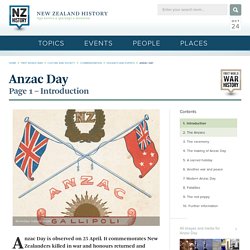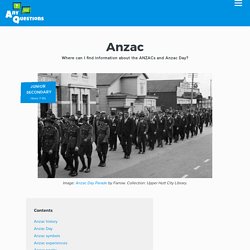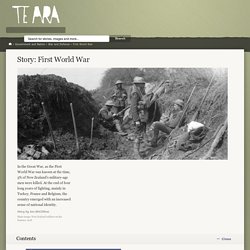

The Story of the Day. Lest we Forget SJ L4 June 2014. New Zealand at War SJ L3 June 2014. Letters from Hell - Gallipoli Heroes in Their Own Words. NZHistory, New Zealand history online. Anzac Day is observed on 25 April.

It commemorates New Zealanders killed in war and honours returned and serving servicemen and women. Anzac Day dates 1916 – Anzac Day gazetted as a half-day holiday 1921 – Anzac Day becomes a full public holiday 1939 – Dawn ceremony widely included in New Zealand Anzac Day commemorations for the first time 1949 – Legislation passed preventing Anzac Day from being 'Mondayised' 1966 – Current Anzac Day Act liberalises activities allowed after 1 p.m. on Anzac Day 2013 – When 25 April falls on a Saturday or Sunday, the Monday will now be a public holiday 2020 – All Anzac Day public ceremonies in New Zealand cancelled because of COVID-19 coronavirus pandemic The date marks the anniversary of the landing of Australian and New Zealand soldiers – the Anzacs – on the Gallipoli Peninsula in 1915.
Thousands lost their lives during the Gallipoli campaign: 87,000 Ottoman Turks, 44,000 men from France and the British Empire, including 8500 Australians. NZHistory, New Zealand history online. NZHistory, New Zealand history online. Anzac poppy The red poppy has become a symbol of war remembrance the world over.

People in many countries wear the poppy to remember those who died in war or who still serve. In many countries, the poppy is worn around Armistice Day (11 November), but in New Zealand it is most commonly seen around Anzac Day, 25 April. In Flanders fields The red or Flanders poppy has been linked with battlefield deaths since the time of the Great War (1914–18). In Flanders fields the poppies blow Between the crosses row on row, That mark our place; and in the sky The larks, still bravely singing, fly Scarce heard amid the guns below.We are the Dead. McCrae was a Canadian medical officer who, in May 1915, had conducted the funeral service of a friend, Lieutenant Alexis Helmer, who died in the Second Battle of Ypres (Ieper). Gallipoli: Drone video of WWI battlefield - BBC News. Remembering: Resources for Anzac Day. Many Answers. ANZAC is the acronym for Australian and New Zealand Army Corps.

It came about In 1914 during World War One when the Australian Army and the New Zealand Army formed the Australian and New Zealand Army Corps. This new unit became known as the Anzacs, to acknowledge both countries. Anzac Day, Anzac poppies and Anzac biscuits are all associated with the Anzac soldiers and are part of the history and culture of New Zealand.
Anzac history The ANZACs (Australian and New Zealand Army Corps) first fought together along with the British Army in the Gallipoli campaign, on 25 April 1915. Te Ara: The Encyclopedia of New Zealand Te Ara is one of the best websites to start with when looking for information on New Zealand topics. To find out about Gallipoli, Choose Stories A-Z from the tabs at the top, and select F. Also try searching for Anzac to bring up all the stories that mention Anzac. Tips: Te Ara links sometimes take you to the Short Story. NZHistory. Letter from Gallipoli. Anzac Day Collection. ANZAC day - Book Overview. Anzac Day and Gallipoli: 25 April. First World War. Origins The First World War was caused by the destabilisation of the balance of power in Europe due to the rise of Germany.

The war began in 1914 when Austria-Hungary invaded Serbia because of the assassination of an archduke. Countries had made alliances with each other, and soon most of Europe was at war. New Zealand was part of the British Empire, and when Britain declared war on Germany, in August 1914, that meant New Zealand was at war too. The two sides were called the Central Powers (Germany, Austria-Hungary) and the Allies, which included the British Empire, Russia and France. New Zealand enters the war New Zealand decided to send soldiers to fight in the war for a number of reasons, including New Zealand’s strong ties to Britain and its concern with keeping trade routes open so it could continue to export to Britain. Within a month New Zealand troops had occupied Western Samoa, which was a German territory.